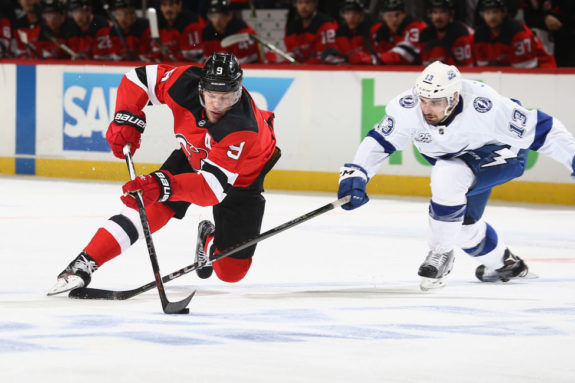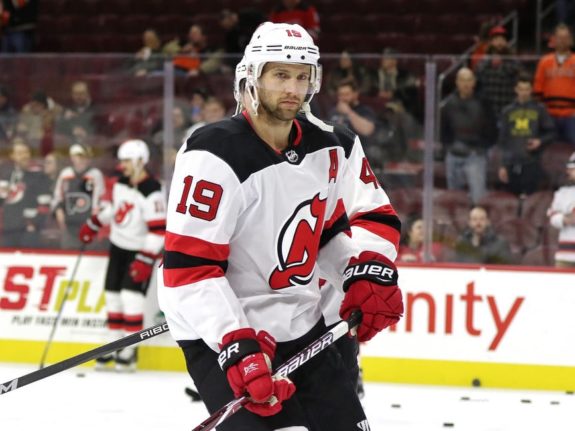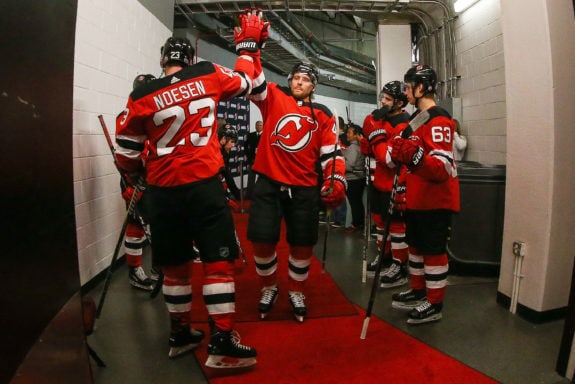One question coming into the season was if the New Jersey Devils would have enough scoring to make the playoffs. While we’re only one game into the season, it appears they may have better forward depth than first thought. They have an underrated first line and have the potential to have adequate secondary scoring behind them.
Hall, Hischier & Palmieri a Top Scoring Line
When discussing the best first lines in the NHL, the trio of Taylor Hall, Nico Hischier, and Kyle Palmieri may not come to mind. Besides Hall, they don’t carry the same name recognition as some other team’s top lines. In spite of flying under the radar, their numbers back up their claim to being a top scoring line.
They played 290 minutes together at 5-on-5 in 2017-18 and were the Devils’ top scoring line. They had a Corsi-for (CF%) of 52.21 percent and carried a 68-62 advantage in high-danger chances. The trio also finished the season with a plus-10 goal differential.

It’s early in the season, but all signs point to these three having a strong 2018-19. We all know what Hall’s capabilities are. And Hischier looks poised to build off what was an already impressive rookie season in 2017-18.
Palmieri is the X-factor on this line. He hasn’t been the strongest player at 5-on-5, but he does score in bunches. However, his preseason may indicate he’s due for a big season at 5-on-5. He led the team in shot attempts, scoring chances, and points. If that continues during the regular season, he may finish with the best point totals of his career.
The Devils’ Middle-Six Has Potential
If there’s going to be offense outside of Hall’s line, it’ll have to come from both of the Devils’ second and third lines. While they might not be the flashiest group, each line has the upside to play a significant part in the Devils’ secondary scoring.
We’ll start with the second line of Marcus Johansson, Pavel Zacha, and Jesper Bratt. Johansson is by far the best of the three and has the track record to back it up. Zacha is a stout defensive forward, but the offense has yet to come around. If it does, they could have three 40-point scorers, especially when Bratt returns from injury.
Making up the Devils’ third line are Miles Wood, Travis Zajac, and John Quenneville. In just one game, they showed the potential to provide offense the Devils need from their third line. In their 5-2 win over the Edmonton Oilers, they had a 68.75% CF% and out-chanced the Oilers 5-0 at 5-on-5. They also finished with two of the team’s five goals.

They aren’t always going to post those kinds of results, but there is a good amount of skill among the three of them. Wood was one of the Devils most efficient scorers in 2017-18, while Zajac — if he stays healthy — is capable of recording around 35-40 points.
Quenneville is more of an unknown, but he has upside. The rookie possesses an effective shot that will prove useful in the NHL. If the pieces come together, he should be able to help round out this line and make it an effective third option.
Related: New Jersey Devils 2018-19 Season Preview
What About the Fourth Line?
It may not be a scoring line, but the Devils’ fourth line has some offensive punch to it. The three members — Brian Boyle, Blake Coleman, and Stefan Noesen — all finished with more than 10 goals in 2017-18.
Of those three, Noesen and Coleman have the best shot to return to double-digit goal totals. Noesen averaged 1.54 points per 60 minutes (P/60) last season. His 10 5-on-5 goals were just below his individual expected goals for (ixGF) of 11.37, too. His production doesn’t seem to be a fluke and bodes well for him moving forward.
Like Noesen, Coleman performed a bit below expectations, too. He had 10 goals at 5-on-5 but had an ixGF of 12.84. Coleman also generates a good amount of shots and chances. He finished 2017-18 with 123 shots on goal at 5-on-5, as well as 126 individual scoring chances. If he produces at the same level, he should be able to at least equal last season’s results.

Boyle is the most likely to regress of the three. He did finish with 13 goals in 2017-18, but five of them came on the power play. Boyle isn’t on either power play unit to start this season, so that will have an effect on his point totals. Even if he fails to reach ten goals, the Devils shouldn’t be hurt by it much. The rest of their group is good enough to make up for anything they lose in a dip of his production.
The Devils Seem to Have the Depth
The Devils don’t have the best group of forwards in the NHL, and that’s not the point I’m trying to make, either. At the same time, they seem to be in better shape than I thought during the offseason.
If Hall, Hischier, and Palmieri stick together, the Devils will have a highly productive first line. Their second line could have a couple of 40-point scorers. Wood, Zajac, and Quenneville seem to have chemistry together and could make for a dependable third line. If they’re able to maintain their health, they seem to have the depth to have a productive offense that will help them compete for a spot in the postseason.
* * *
Advanced stats from Corsica Hockey, Natural Stat Trick